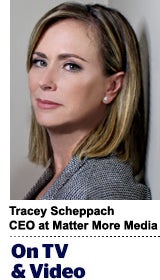“On TV And Video” is a column exploring opportunities and challenges in advanced TV and video.
Today’s column is written by Tracey Scheppach, CEO at Matter More Media.
Disclosure: Nielsen is a client of the author.
Change in cross media measurement and addressable TV is messy and slow coming, lagging behind vastly accelerated consumer behaviors.
But the new deal between Roku and Nielsen has the potential to truly accelerate many factors that the TV industry has been longing for, and desperately needs.
In terms of addressable TV, in late 2019 I assessed how three percent of the linear marketplace was addressable-capable. With so many people and initiatives working hard to scale this number there are some victories worth celebrating. But sadly, the number is basically left unchanged.
This new alliance between Roku and Nielsen, however, provides the caffeine to speed things up.
This deal includes a large data deal, new support for Nielsen’s role in CTV currency and the sale to Roku of Nielsen’s AVA business – which was built into a very powerful addressable solution, including top talent and 700+ filed patents globally. This deal could significantly accelerate addressable TV across the full 16 minutes of linear television as well as combine with already addressable-capable CTV inventory.
Though Roku is a powerhouse in CTV, many industry insiders don’t realize the power of the Roku TV operating system. Roku has the largest scale, at 38% share of the US smart TV market. Integrating the Nielsen AVA team’s addressable solution into this type of scale will power the ability to do addressability on all inventory, CTV and now linear – basically anything that appears on Roku glass. This cross-media addressable TV solution is something marketers are aggressively looking for, and gives Roku a valuable tool to meet their needs.
Three key values embody this alliance:
Addressable TV at scale
There are two primary ways addressable TV is enabled: through a set top box or a smart TV. With cord-cutting, boxes are declining, and smart TVs are expanding. Per Nielsen, at least 40 million households are either exclusively an over the air (OTA) home or broadband only, without a traditional set top box. At the same time, smart TV penetration continues to rise, as 67.4 million households have at least one enabled smart TV.
Roku recently announced they have 51.2 million active accounts, up by approximately 14 million accounts in 2020, which means (based on my calculations) that Roku has the ability to enable at least 10% of all TV impressions to be addressable – about twice as much as its nearest competitor, Comcast. There is a lot of work to do to get there, but this could create billions of dollars of value and can put Roku in the clear leadership position.
The big picture of viewership
It is clear that Nielsen had an awakening around a fuller picture of all viewing. Due to massive fragmentation, its panel, although clearly a critical input into its Nielsen ONE platform, did not have enough scale to account for all viewing, especially as addressability scales. Nielsen announced in November 2020 a great first step to advancing cross media measurement with big data sets from DirecTV, DISH and Vizio, totaling 55 million devices.
This alliance with Roku adds an additional 51.2 million subscribers with its related devices and viewing of both content and ads. Roku also has a core understanding of the overlap with CTV viewership via its OneView identity graph. This data set doubles Nielsen’s coverage and helps it move toward its mission to rebuild its full visibility solution, Nielsen ONE.
Currency acceleration
Over the last several years, consumer fragmentation has challenged Nielsen’s ability to bring full coverage across linear and CTV viewership into its ratings and resulting currency. So, many advertisers have had to rely on homework graded by those selling the inventory.
In this alliance, Roku will use Nielsen’s currency in all of its deals, including campaigns run across its vast CTV footprint, and soon incremental reach as well as all addressable TV deals.
Also important is Nielsen’s progress bringing to market, in the second half of 2021, an addressable TV measurement solution that enables ad insertion on top of previously sold C3/C7 linear inventory, in a way that advertisers are paying for actual impressions viewed. The Roku-Nielsen alliance helps accelerate these needed solutions as we work to scale addressable capabilities.
Much work lies ahead to achieve the value of this alliance and many people need to lean in. But make no mistake: the values demonstrated in this deal are all big steps in the right direction to truly unlock cross media measurement and addressable TV for the industry.
If we can all contribute to that value, with our own innovations, it’s full speed ahead toward inventing tomorrow’s holistic TV ad market.
Follow Tracey Scheppach (@scheppach), Matter More Media (@Make_it_MM) and AdExchanger (@adexchanger) on Twitter.












